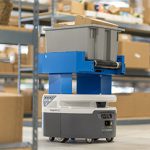IMPLEMENT AUTONOMOUS MOBILE ROBOTS IN A GOODS-TO-PERSON OPERATION THE RIGHT WAY FOR THE RIGHT REASONS

Recent research from Gartner found that 66% of supply chain organizations point to labor availability constraints as the primary driver behind their investments in robotics – and explains in other research that too many options and lack of internal expertise are slowing adoption.
However, using robotic solutions, like autonomous mobile robots in assisted picking and staging operations, is still one of the most flexible and scalable solutions. Given so many options, how can fulfillment enterprises make the most efficient decisions in a fast-moving environment?
S&H Systems’ Matt Watkins (Director, Technology and Product Development), and Noah Cornett (Sr. Applications and Solutions Engineer) share insights for a successful approach to the implementation of Autonomous Mobile Robots (AMRs) in a goods-to-person operation.
Too many options
- Begin vetting possible solutions by engaging with a trusted integrator, or advanced technologies experts. Leverage the knowledge of experts to formulate a go-to-bid plan.
- This first step could take from 6 months to 2 years. Companies need that time to collect the correct data – working with solutions experts will help you understand what data you need, and in some cases how to collect the right data. Compare it to the research you do before buying a home – it’s an early investment in understanding AMR benefits in your unique situation.
- Why does the data matter so much? The acceleration of COVID pressured many companies to innovate and install quickly – and they are now finding that they are outgrowing the technology they chose – or it’s no longer a good fit. In some cases, there was a fundamental misunderstanding of AMR and AGV technology, an expectation of an almost AI level of operation, of comparing the machines to human operators.
- Consider a small trial by identifying one or two processes that are repeatable. AMRs are best for repeatable processes – and a trial can help with standardization. Take the mindset of simplicity to start – maybe trialing a ‘hot pick’.
- Look for installations based in your own industry or service area. There are a lot of start-ups coming out of other high-tech industries who may not have the right install base – or may have been purchased and rolled up into larger companies. It’s important that you have an opportunity to view the process.
Lack of Internal Resources
- A good integrator may be your best choice, one that has the training and expertise in your automation solution, and has the support team you need to meet challenging market changes. No matter how user-friendly a solution is there is always something that can go wrong and you’ll need a team who can marshal the resources you need.
- Again, take your time to collect the right data, and to choose the right expertise partner, someone who can help you understand the characteristics of AMRs to goods being handled, order and pick volumes, and growth projections
Integration into current operations can be a challenge
- There are a few ways to ‘on ramp’ a solution. Some AMR companies have a rental/lease program that helps both the company and its employees get used to the process and the machines.
- Many companies are building training centers, since the install base may not be accessible.
- Choose experts who understand your chosen technology, and may have partnerships that will allow you to see the solution in action.
Reward – risk confusion
- Facilities and products are changing rapidly so it’s best to be flexible, and remember that the ‘playbook’ that worked a few years ago may not be relevant today.
- Work to create a robust ROI calculator, remembering to factor in training, subject matter experts, maintenance and continued employee safety.
- We strongly recommend a small trial. AMRs are a great option to test the waters for new goods-to-person mechanization.
In this fast-moving fulfillment environment, building solid and trusted relationships is important. Take your time to determine, collect and understand your data. This vetting process of partner and data will help you build a solid platform – to help your company grow from novice to proficiency.
